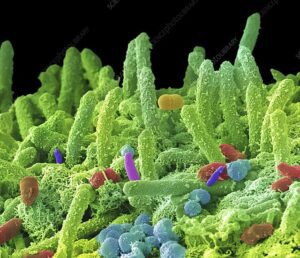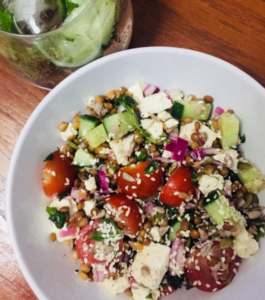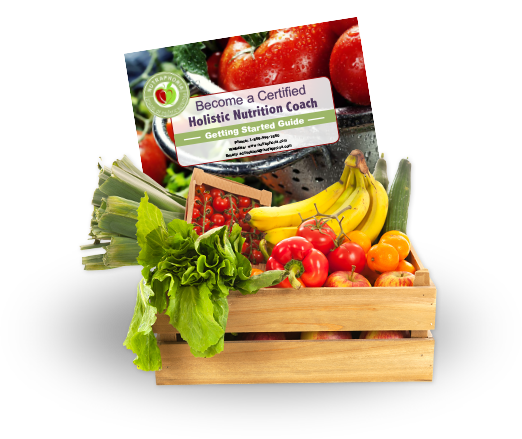November 23, 2022
I’m a neuroscientist fascinated by the effects of food and nutrition on brain function. The gut microbiome is becoming a key player in not only how we digest food, but also how our brain works – so it’s a hot topic in both neuroscience and nutrition!
The digestive system is the engine of the body, and it has its own brain – the enteric nervous system – which communicates with the central nervous system via the vagus nerve. The gut’s main job is to take the foods (fuel) we eat and make glucose to power cells, and extract the nutrients needed by our body.
But we aren’t the only ones getting fed when we eat a meal.
Our intestines are home to an entire ecosystem of microorganisms that influence how our body works and even the moods we feel.

Bacteria forming a microbiome – Source https://www.sciencephoto.com/media/726921/view CC BY-SA 4.0
The gut microbiome
Trillions of microbes (including bacteria, archaea and fungi) live in the gut and interact with our body. These microbes form a “microbiome”, defined as the full collection of genes of all the microbes in a community.
Microbes interact within their communities, and respond to their surroundings – including the foods we eat. Our microbial populations shift when their environment changes, so eating a diet full of refined sugar and saturated fat encourages different microbes to grow in comparison to a healthy diet with abundant fibre.
I think of it like the different soils that plants grow in – certain plants only grow well in a nutrient rich compost, some plants can grow through concrete…
Probiotics and Prebiotics
We can change our internal environment by consuming probiotics or prebiotics.
Probiotics are a foods or supplements that contain microorganisms (such as Lactobacillus or Bifidobacterium) or stimulate the growth of microorganisms.
Probiotic-rich foods include live yoghurt, kefir, miso, tempeh, kombucha, kimchi, buttermilk, sauerkraut and other fermented vegetables. Adding these foods to meals can really boost probiotic benefits. Fermented foods not only have living microbes that aid gut health, but these foods are also prebiotic – the microbes have already processed these foods, making them easier to digest and often unlocking nutrients that our own body could not otherwise have accessed.
The difficulty with taking probiotics as food supplements is that they land in a vat of gastric acid in your stomach. Gastric acid (which is hydrochloric acid) is an key element of digestion because it:
1) breaks down proteins into composite amino acids,
2) provides the appropriate pH for digestive enzymes like pepsin to work,
3) kills harmful microorganisms that might have been ingested along with the food (those bad bacteria like E. Coli. or Salmonella that can make you really sick).
Unfortunately gastric acid can also kill the good bacteria in probiotics.
Recolonising the gut
Avoiding stomach acid is where faecal microbiome transplants (FMTs) can come in useful. Faecal matter, (or poop, or whatever you want to call it), is collected from a donor, mixed with a saline, strained, and inserted into a patient’s large intestine or bowel by colonoscopy or enema, so the microbes bypass the stomach! However, as this is quite invasive, researchers have been investigating new ways of making capsules that can be ingested orally and can survive stomach acid.
FMTs can treat life threatening infections with Clostridium difficile (C. diff), an antibiotic resistant bacteria that causes debilitating diarrhoea. Doctors discovered that FMTs can restore good gut bacteria to combat C. diff. It’s kind of like a battle between good and evil, but it’s taking place in your gut.
Not feeling the FMT? There are other ways to help out your gut bugs
In order for the good bacteria to survive in the gut, you need to feed them! Prebiotics are often non-digestible fibres that enable beneficial bacteria to stick to the intestinal wall and also helps to stimulate their growth. I think of them as the nutrient rich fertiliser that helps plants grow.
Prebiotic-rich foods include bananas, onions, asparagus, soy beans, Jerusalem artichokes, whole oats, wheat, barley, garlic, flaxseeds, legumes – including beans and lentils, tomatoes and leafy green vegetables like spinach and kale.
Raw foods like salads are a great way of getting prebiotics into your diet because cooking foods can change their nutrients… see below for my microbiome friendly salad recipe…
How does the gut microbiome influence brain health?
Your gut flora gets to work on digesting the foods that you eat, particularly fibre, and they generate metabolites (bioactive molecules) in the form of short chain fatty acids (SCFAs) that regulate metabolic processes – including insulin sensitivity. This means that the gut microbiome could help to restore insulin sensitivity in those who have developed insulin resistance and might be able to halt the development of metabolic syndrome and type 2 diabetes.
Experimental studies with mice have shown the potential of probiotics and prebiotics to treat many conditions, including irritable bowel syndrome, autism spectrum disorder, and neurodegeneration like Parkinson’s disease.
The gut microbiome also seems strongly linked to mood – and the microbes in the gut are able to communicate with the brain via the vagus nerve. This gut-brain-microbiome connection appears critical and has spawned the field “psychobiotics” – an up and coming area of ‘nutritional’ psychiatry. Psychobiotic research focusses on how probiotics or prebiotics could treat mood disorders, and how gut dysbiosis might cause depression and anxiety, opening up a whole new field of therapies for people experiencing mental health conditions.
Green lentil Greek salad
(Serves 2-3 people, or me for 3-4 days of work lunches)

green lentil feta prebiotic wonder salad
Ingredients
1 tin of ready cooked green lentils, drained and rinsed (lentils are prebiotic powerhouses – your gut bugs are gonna chow down on these and be so happy)
1 red onion chopped up small (gut bugs dig onion)
10-15 cherry tomatoes chopped into halves or quarters
Half a continental cucumber chopped into cubes
Half a block of feta, crumbled (protein without the bloatein, dairy with less scary…)
1/4 cup pumpkin seeds, I also threw in some sesame and sunflower seeds. Gotta get those antioxidants, iron, zinc, magnesium and omega-3s in.
1/2 cup walnuts (kind of chopped). Walnuts look like brains, which is why I think I like them so much.
Chopped fresh mint leaves (1-2 handfuls)
Dressing
Juice of 1 lemon
1 tablespoon Apple Cider Vinegar
2 tablespoons avocado oil
1 clove of garlic (crushed)
1 teaspoon dried sumac (or paprika / sprinkle of chilli if you can’t find sumac)
Salt / Black pepper to taste
Directions
Cut up all the salad ingredients and mix together in a big bowl. Mix up dressing. Pour over salad. Voila. Eat with spoon straight from bowl or serve on a plate like a civilised person.


